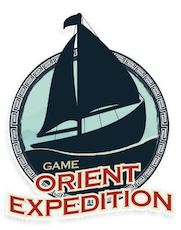Captain’s Diary: Arriving to Krakatoa

Looking for points?
(Português) Responda corretamente à pergunta ao final desta página e ganhe pontos no Game Oriente
Without any wind, we followed on by motor, being extra careful with the fishing nets that were around all the way. It was night time and we had already gone around two large fishing nets. However, at 1 am, we were stuck on one of them. The net’s cable got stuck on the boat and Wilhelm had to dive and cut them with a knife to we could continue.
After that, we changed course to avoid the route of the big ships and more fishing nets. We went by several trolleys pulling cargo ships and, when we reached the strait between Java and Sumatra, the transit of ferries was intense and sailing had to be done very carefully.
We reached Krakatoa at 12:30 pm and we anchored in front of the volcano, where there was a contingency of eight park guards. We requested permission to visit and payed the taxes necessary to enter and film the area. We shot everything during the afternoon and made sure to capture the crater with the drone.
Kratakoa’s volcano was widely known after its eruption in 1883, the second largest and destructive one in history. It had 22 hours of explosions. The people thought the volcano was extinct, its crater had 16 km of diameter. The volcano was 2 thousand meters tall and, with the explosions, it fell down and all of the mountain disappeared. The explosion was so violent it threw rocks as far as 27 km and the sound could be heard 5 thousand km away in Rodrigues Island, Australia, the Philippines and India.
The effects of the explosion with the ashes and dust in the atmosphere made the temperature of the world drop. Various tsunamis occurred in Java and Sumatra, with waves of up to 40 meters and 36 thousand died.
The current Anak Krakatoa (son of Krakatoa) might even be more powerful if an explosion occurs in its 50 km crater. It’s 800 meters tall and crows 5 meters annually. The son of Krakatoa is an active volcano and is closely monitored by scientists. The alert level is 2. Scientists say it might reach the same height as Krakatoa and such a catastrophic explosion might affect most of the planet.
We decided to sleep in the berth and continue the trip in the morning. At night, on the boat’s cockpit, I stared out the window looking at the volcano and imagined its greatness and how small we are next to nature’s power.
We left on the next day, at 7:30 am, to Mentawai, 440 miles away. The wind, of NE at 5.2 knots, calm sea and speed at 6.8 knots.
All the navigation was done via motor, with alterations during the morning with earthly wind and in the afternoon when the rain came followed by strong winds of up to 35 knots.
On this crossing, we caught a small tuna. We arrived on the island in the afternoon of September 18th and our friends Alexandre and Luana were waiting for us. Before we entered the docking bay, we made contact via radio and he gave us the coordinates to his vessel so we could reach his lodge, the Ulau Manua Resort.
Knowledge of Geography is essential to getting to know each particularity of the world. Do you have interest in the area? So sign up for Estácio!
